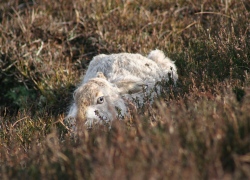
News
« Return to News23 November 2017
Peak District Mountain Hare Research
PAA is sponsoring vital research into mountain hare (Lepus timidus) in the Peak District in an effort to understand how sustainable this isolated population is.
The research was established by the People’s Trust for Endangered Species (PTES) and is being conducted by Carl Bedson of Manchester Metropolitan University. PAA is contributing funding to this work over a 3 year period, along with PTES, Hare Preservation Trust, British Mountaineering Council, Queen’s University Belfast and South-West Action for Hares.

Mountain hares are native to the Scotland Highlands and were introduced back into the Peak District in the 1800s after the last Ice Age brought about their demise in England. They occur nowhere else in England.
Their numbers in the Peak District are reported to be relatively stable (Mallon et al 2012) although the species has been lost from some of the smaller, more isolated areas of moorland such as those in the South West Peak and at Eyam Moor in the Dark Peak (www.peakdistrict.gov.uk).

The PTES research aims to understand the factors influencing the success or otherwise of this group of mountain hares which may help to guide other mammal reintroduction efforts and inform advice for safeguarding the Peak District mountain hare population.
The particular issues faced by the mountain hares include the harsh moorland environment and their isolation from other populations which means that the species cannot be sustained by inward migration of other hares. PTES also reports that the potential impact of changing land use practices on mountain hare are not yet understood and that climate change may bring additional challenges associated with changing weather patterns and extremes (www.ptes.org/grants/uk-mammal-projects/mountain-hares-peak-district).

The research is using novel techniques to gain a better understanding of mountain hare numbers and to investigate both habitat associations and the effects of human infrastructure and disturbance (there are a number of major roads crossing the Peak District introducing risks of direct mortality from collisions with traffic).
It is hoped that the study will shed light on how hare populations might respond to changes in land use and other pressures and to inform possible future re-introductions of this fascinating species by PTES. We are delighted to be helping with this valuable work and look forward to the final results of the study which are due in 2018.
Further information about the Peak District Mountain Hare research project can be found on the PTES Website or on Carl’s website. You can also contact Carl direct by email on carl.bedson@btinternet.com.
References
Mallon, D., Alston, D. and Whiteley, D. 2012. The Mammals of Derbyshire

